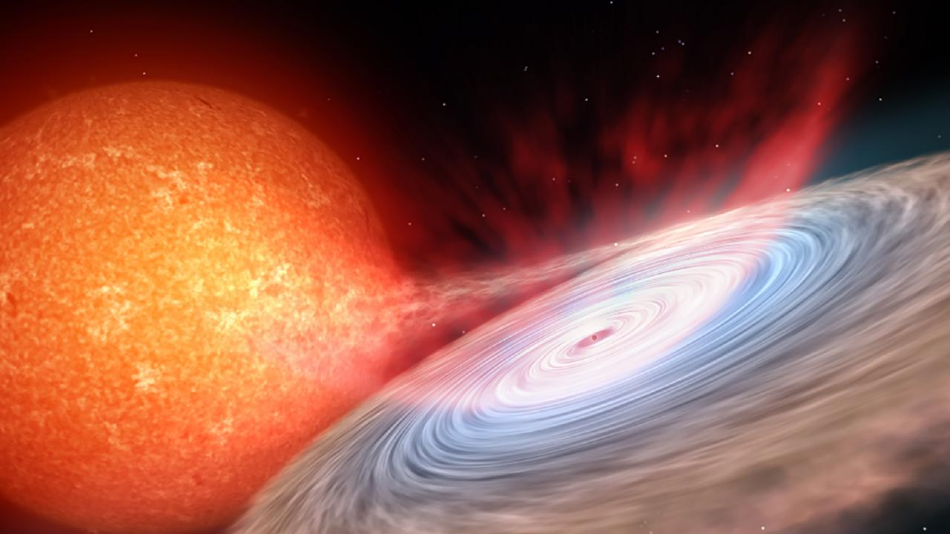Aug 28 2020
For the first time, scientists from the Institute of Astrophysics of the Canary Islands (Instituto de Astrofísica de Canarias-IAC) have observed the continuous infrared emission from winds generated during the outburst of a black hole in an X-ray binary.
 Artistic impression of the constant emission of winds produced during the eruption of a black hole in an X-ray binary. Image Credit: Gabriel Pérez Díaz, SMM (IAC).
Artistic impression of the constant emission of winds produced during the eruption of a black hole in an X-ray binary. Image Credit: Gabriel Pérez Díaz, SMM (IAC).
To date, scientists have detected such flows of material only in other wavelength ranges based on the phase where the black hole is ingesting its surrounding material.
The new study offers the first proof that the winds indeed exist through the entire evolution of the outburst, but independently of the phase. This finding brings investigators one step closer to interpreting the elusive processes of accretion onto stellar-mass black holes.
The study was recently published in the Astronomy & Astrophysics Letters journal and was selected as an “outstanding article” by the journal itself.
As their name implies, X-ray binaries are essentially binary stars that produce powerful X-ray radiations. These binaries are created by a compact object, usually a black hole, with a stellar companion.
Companions in low mass X-ray binaries (LMXB) have masses that are less than, or equal to, the mass of the Sun. The two stars in these systems circle at a very small distance, and because of this small distance, some mass of the star tends to fall into the gravitational well of the black hole, creating a flat disk of material around it. Such a process is referred to as accretion, and the disk is actually an accretion disk.
Certain X-ray binaries—called transitory—transformed from quiescent states to eruptive states, where the black hole exhibits an augmented accretion rate, so that the material present in the disk tends to heat up and reaches values between 1 K and 10 million K. In quiescent states, the proportion of mass accreting onto the black hole is negligible and its brightness is also so low that it cannot be detected from the Earth.
At the time of these outbursts, which can persist from weeks to several months at a stretch, the system discharges a massive flux of X-rays, and its brightness increases by several magnitudes.
But scientists are still not clear about the kind of physical processes that take place during such accretion episodes.
These systems are places where matter is subjected to gravitational fields which are among the strongest in the universe, so that X-ray binaries are physics laboratories which nature provides us for the study of compact objects, and the behaviour of the matter surrounding them.
Javier Sánchez-Sierras, Study First Author and Predoctoral Researcher, Institute of Astrophysics of the Canary Islands
The ejection of winds, or material, occurring during accretion episodes is one of the most significant physical processes that investigators need to figure out.
The study of winds in those systems is a key to understand accretion processes, because the winds can get to expel even more matter than is accreted by the black hole.
Teo Muñoz-Darias, Study Co-Author and Researcher, Institute of Astrophysics of the Canary Islands
Same Wind, Different States
The latest study describes the discovery of winds from the black hole, called MAXI J1820+070, in the infrared, during the outburst that occurred during 2018–2019.
In the last 20 years, winds have been visualized in X-rays at the time of outburst, called soft, where the radiation produced by the accretion disk was found to be dominant, demonstrating high luminosity.
In the recent past, the same research team from the IAC has discovered winds in the hard state of accretion at visible wavelengths. This accretion state is defined by the appearance of a jet, which emerges essentially in a perpendicular direction to the accretion disk, and which also discharges powerfully at radio wavelengths.
“In the present study, we have shown the discovery of infrared winds which are present during both the hard and soft accretion states, during the full evolution of the eruption, so that their presence does not depend on the accretion state, and this is the first time that this type of winds has been observed,” emphasized Sánchez-Sierras.
The team was able to demonstrate that the kinematic characteristics of the wind are quite analogous to those visualized earlier in 2019 in the visible range, reaching velocities of up to 1.800 km/second.
These data suggest that the wind is the same for both cases, but its visibility changes wavelength during the evolution of the eruption, which would indicate that the system is losing mass and also angular momentum during the process of the eruption.
Teo Muñoz-Darias, Study Co-Author and Researcher, Institute of Astrophysics of the Canary Islands
For the researchers, these outcomes are highly significant because they add a new dimension to the universal picture of the winds in such kinds of systems, and signify advancement towards the aim of completing one’s interpretation of the accretion processes onto stellar-mass black holes.
Journal Reference:
Sánchez-Sierras, J & Muñoz-Darias, T (2020) Near-infrared emission lines trace the state-independent accretion disc wind of the black hole transient MAXI J1820+070. Astronomy & Astrophysics Letters. doi.org/10.1051/0004-6361/202038406.